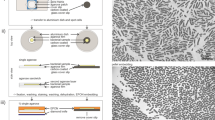Abstract
Ultrathin sections of sporulatingBacillus thuringiensis were examined in a transmission electron microscope. Less than 1% of the about 2,000 approximately sagittal sections of the bacterial cells examined contained two endospores per cell. This finding clarifies the majority of textbook and research reports (which tend to be ambiguous), contradicts several of the most recent textbook reports, and confirms three unillustrated textbook reports, in relation to the occurrence of disporous bacilli. Electron microscopic evidence of the observation is presented, apparently for the first time.
Similar content being viewed by others
References
Alcamo IE (1990) Fundamentals of Microbiology. Third Edition. The Benjamin/Cummings Publishing Company, Inc., Redwood City, California, 960 pp
Atlas RM (1984) Microbiology: Fundamentals and Applications. Macmillan Publishing Company, New York, New York, 880 pp
Barker AN, Gould GW & Wolf J (Eds) Spore Research 1973. Academic Press, London, England, 277 pp
Barker AN, Wolf J, Ellar DJ, Dring GJ & Gould GW (Eds) (1977) Spore Research 1976. Vol. 1. Academic Press, London, England, 449 pp
Boyd RF (1988) General Microbiology. Second Edition. Times Mirror/Mosby, St. Louis, Missouri, 863 pp
Brock TD & Madigan MT (1991) Biologt of Microorganisms. Sixth Edition. Prentice Hall, Englewood Cliffs, New Jersey, 874 pp
Chambliss G & Vary JL (Eds) (1978) Spores VII, Seventh International Spore Conference, Madison, Wisconsin. American Society for Microbiology, Washington, D.C., 354 pp
Claus D & Berkeley RCW (1986) In: Bergey's Manual of Systematic Bacteriology. Vol. 2 Sneath PHA (Ed) (pp 965–1599) Williams & Wilkins Company, Baltimore, Maryland
Creager JG, Black JG & Davison VE (1990) Microbiology: Principles and Applications. Prentice Hall, Englewood Cliffs, New Jersey, 839 pp
Davis BD, Dulbecco R, Eisen HN & Ginsberg HS (1980) Microbiology. Third Edition. Harper and Row, Hagerstown, Maryland, 1355 pp
Freeman BA (1979) Burrows Textbook of Microbiology. Twenty-first Edition. WB Saunders Company, Philadelphia, Pennsylvania, 1138 pp
Fuerst R (1983) Microbiology in Health and Disease. Fifteenth Edition. WB Saunders Company, Philadelphia, Pennsylvania, 688 pp
Gibbons JR & Grimstone AV (1960) On flagellar structure in certain flagellates. J. Biophys. Biochem. Cytol. 7: 697–710
Halvorson HO, Hanson R & Campbell LL (Eds) (1971) Spores V, Fifth International Spore Conference, Fontana, Wisconsin. American Society for Microbiology, Washington, D.C., 471 pp
Jensen MM & Wright DN (1989) Introduction to Microbiology for the Health Sciences. Second Edition. Prentice-Hall, Englewood Cliffs, New Jersey, 704 pp
Joklik WK, Willett HP & Ames DB (1980) Zinsser Microbiology. Seventeenth Edition. Appleton-Century-Crofts, New York, New York, 1539 pp
Lamanna C & Mallette MF (1965) Basic Bacteriology. Third Edition. Williams & Wilkins, Baltimore, Maryland, 1001 pp
Levinson HS, Sonenshein AL & Tipper DJ (Eds) (1987) Spores VIII, Eighth International Spore Conference, Woods Hole, Massachusetts. American Society for Microbiology, Washington, D.C., 317 pp
Luft JH (1961) Improvements in epoxy resin embedding methods. J. Biophys. Biochem. Cytol 9: 409–413
Prescott LM, Harley JP & Klein DA (1990) Microbiology. WC Brown Publishers, Dubuque, Iowa, 883 pp
Stanier RY, Ingraham JL, Wheelis ML & Painter PR (1984) The Microbial World. Fifth Edition. Prentice-Hall, Englewood Cliffs, New Jersey, 689 pp
VanDemark PJ & Batzing BL (1986) The Microbes: An Introduction to Their Nature and Importance. The Benjamin/Cummings Publishing Company, Inc., Menlo Park, California, 991 pp
Venable JM & Coggeshall R (1965) A simplified lead citrate stain for use in electron microscopy. J. Cell Biol. 25: 407
Whiteley HR & Schnepf HE (1986) The molecular biology of parasporal crystal body formation inBacillus thuringiensis. In: Ornston LN, Balows A & Baumann P (Eds) Annual Review of Microbiology 40: 549–576. Annual Reviews, Inc., Palo Alto, California, 712 pp
Wilson GS & Miles AA (1964) Topley and Wilson's Principles of Bacteriology and Immunity. Fifth Edition. Williams & Wilkins Company, Baltimore, Maryland, 1191 pp
Author information
Authors and Affiliations
Rights and permissions
About this article
Cite this article
Chapman, G.B., Herk, Av. & Eguía, J.M. The occurrence of disporousBacillus thuringiensis cells. Antonie van Leeuwenhoek 61, 265–268 (1992). https://doi.org/10.1007/BF00713934
Received:
Accepted:
Issue Date:
DOI: https://doi.org/10.1007/BF00713934



